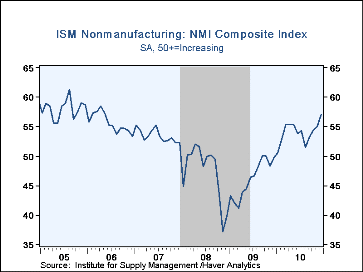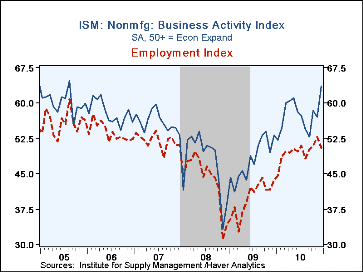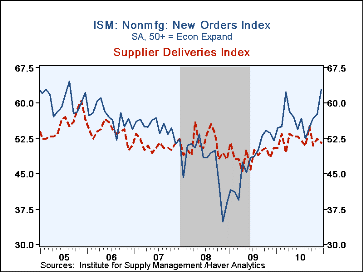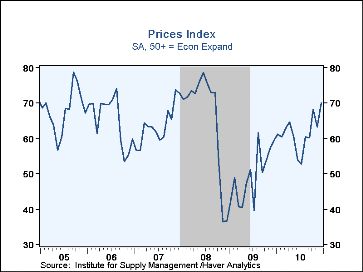 Global| Jan 05 2011
Global| Jan 05 2011U.S. ISM Nonmanufacturing Index Highest Since 2006
by:Tom Moeller
|in:Economy in Brief
Summary
For the fourth consecutive month the U.S. service sector improved. The December Composite Index for the service and construction sectors from the Institute for Supply Management (ISM) rose to 57.1.0 from 55.0 in November. The latest [...]
For the fourth consecutive month the U.S. service sector improved. The December Composite Index for the service and construction sectors from the Institute for Supply Management (ISM) rose to 57.1.0 from 55.0 in November. The latest beat Consensus expectations for a reading of 55.5. It was the highest since May 2006 and was up from a low of 37.2 late in 2008. Since the series' inception in 1997 there has been a 65% correlation between the level of the composite index in the nonmanufacturing sector and the q/q change in real GDP for the services and the construction sectors.
The performance of the components of the ISM Index was split last month. The business activity index recovered its November decline with a rise to its highest since 2005. The new orders series also was at its highest since 2005. To the downside, the employment figure declined to barely break-even. Eighteen percent (NSA) of respondents increased hiring while an increased 16% reported fewer jobs. Since the series' inception in 1997 there has been an 80% correlation between the level of the ISM nonmanufacturing employment index and the m/m change in payroll employment in the service-producing plus the construction industries. The supplier deliveries index also fell as delivery speeds sped up.
The pricing power index improved to its highest since September 2008. An increased 35% of respondents reported higher prices while 5% reported them lower. At the worst, late in 2008, 41% reported lower prices. Since its inception ten years ago, there has been a 71% correlation between the price index and the q/q change in the GDP services chain price index.
Beginning with the January 2008 Nonmanufacturing Report On Business ®, the composite index is calculated as an indication of overall economic conditions for the non-manufacturing sector. It is a composite index based on the diffusion indices of four of the indicators (business activity, new orders, employment and supplier deliveries) with equal weights.
The ISM data are available in Haver's USECON database.
| ISM Nonmanufacturing Survey | Dec | Nov | Oct | Dec '09 | 2010 | 2009 | 2008 |
|---|---|---|---|---|---|---|---|
| Composite Index | 57.1 | 55.0 | 54.3 | 49.8 | 54.1 | 46.2 | 47.3 |
| Business Activity | 63.5 | 57.0 | 58.4 | 53.2 | 57.5 | 48.0 | 47.4 |
| New Orders | 63.0 | 57.7 | 56.7 | 52.0 | 56.9 | 47.9 | 47.0 |
| Employment | 50.5 | 52.7 | 50.9 | 43.6 | 49.7 | 39.9 | 43.8 |
| Supplier Deliveries (NSA) | 51.5 | 52.5 | 51.0 | 50.5 | 52.2 | 49.0 | 51.1 |
| Prices Index | 70.0 | 63.2 | 68.3 | 59.6 | 61.5 | 49.4 | 66.0 |
Tom Moeller
AuthorMore in Author Profile »Prior to joining Haver Analytics in 2000, Mr. Moeller worked as the Economist at Chancellor Capital Management from 1985 to 1999. There, he developed comprehensive economic forecasts and interpreted economic data for equity and fixed income portfolio managers. Also at Chancellor, Mr. Moeller worked as an equity analyst and was responsible for researching and rating companies in the economically sensitive automobile and housing industries for investment in Chancellor’s equity portfolio. Prior to joining Chancellor, Mr. Moeller was an Economist at Citibank from 1979 to 1984. He also analyzed pricing behavior in the metals industry for the Council on Wage and Price Stability in Washington, D.C. In 1999, Mr. Moeller received the award for most accurate forecast from the Forecasters' Club of New York. From 1990 to 1992 he was President of the New York Association for Business Economists. Mr. Moeller earned an M.B.A. in Finance from Fordham University, where he graduated in 1987. He holds a Bachelor of Arts in Economics from George Washington University.










